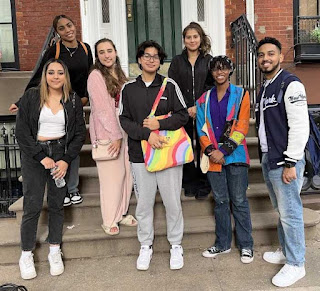New York City Walking Tour of 19th Century Sites of Women’s Suffrage Activism by Lisa Merrill
On Thursday, September 29, 2022, I led students from my “Gender, Race and the Struggle for the Woman’s Vote” class on a walking tour in NYC of some of the sites of 19th century women’s suffrage activism, highlighting the roles played by persons of color. Some of the buildings no longer exist, but through my own archival research I could bring students to the location of churches where Sojourner Truth, Harriet Tubman, and Frederick Douglass spoke.
Here we are at the original site of Mother Zion AME Church in Greenwich Village.
As we walked through the streets, making history come alive, I introduced them to the homes of figures we are studying, such as suffrage and education activist Sarah Smith Garnet, wife of Rev. Henry Highland Garnet:
When I first “mapped” out our trip, I selected nine sites in downtown NYC, and 12,000 steps as I introduced students to the sites and the neighborhood referred to as “Little Africa” in the 19th century. Space is an important feature of my historical research, and I loved being able to share that with my students as we explored places most significant to the activists we have been studying; we honor the ancestors.
One of the wonderful students in this class is Center for “Race,” Culture, and Social Justice student fellow Ariadne Morales, and I invited her to share her reactions to the trip in this blog: Ariadne: As a student in Dr. Merrill's class, I found it absolutely fascinating how the class was able to actually see these important sites in person due to ourselves previously studying these activists in class. Being present on site has much more of an impact compared to reading about in class because you are truly there and you think more about the presence of the activist. It was interesting to see how regular people who may live in a building that someone so important used to live in, may not realize the impact these suffragists had on society. I was also delighted to see that when visiting a building where an activist lived, a person was sitting on the steps smiling at us observing his home. My favorite location we visited was the Church because I've always appreciated the architecture implemented in it. The ambiance of the city was spectacular within itself which made the trip even more exhilarating. We stumbled upon diverse groups of people and truly experienced the heart of the City which is something I truly enjoyed. We also ate “NYC” pizza at a park nearby and walked back to the subway to end our trip. Everyone in the class had a great time expanding our knowledge on these sites and comparing the photos of the sites years ago compared to now and seeing how much they've evolved over time.
Lisa Merrill, Ph.D. (she, her) is Professor, of Performance Studies and Rhetoric, Department of Writing Studies and Rhetoric teaching courses and publishing research about performance studies, critical race and cultural studies, and women's and LGBTQ history in a range of cultural artifacts, artworks, and performances. Dr. Merrill publishes widely in the US and UK, where she has presented her research at the International Museum for the Study of Slavery, Liverpool, England, and the Institute for Black Atlantic Research, UCLAN, UK. At Hofstra she regularly stages re-enactments of Black historical figures as part of Performing History. On the walking tour Dr. Merrill discusses in this blog, she has brought Hofstra students into her research.








Comments
Post a Comment